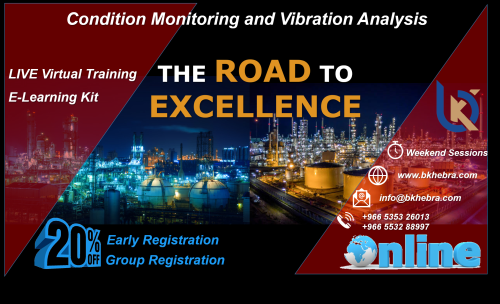| Training Code | Date | Duration | Venue | Fees |
|---|---|---|---|---|
| Keep following, we are updating our training schedules. | ||||

An organization with skilled condition monitoring technicians and analysts experiences lower maintenance costs and higher plant reliability. Condition monitoring allows you to detect the onset of failure and detect when the conditions exist that will cause future failures. Coupled with an effective planning and scheduling process, maintenance costs and production downtime can be dramatically reduced.
Rotating machinery, electrical equipment, and practically every other type of equipment you may operate in your plant provide an indication when failure is initiated, for example, when the bearing has the smallest crack forming. While it is necessary to understand how equipment fails, as a general comment, we can achieve anywhere from weeks, months, and even years of warning before failure occurs. That enables us to establish a corrective maintenance plan and schedule the work at the optimal time in order to reduce spare parts holding costs, the time required to perform the corrective maintenance, and the impact on production. Avoiding catastrophic failure obviously reduces the safety and environmental risks, and the possibility of secondary damage. Proper planning increases the quality of the work performed and reduces safety risks for the person performing the work.
The unexpected breakdown of rotating machinery is the single largest cause of emergency breakdowns in all types of industry. Vibration surveillance to detect problems and analysis of the vibration signals to identify proven tools to eliminate this downtime. This course will explain the physical basis for vibration and analysis through identification of discreet frequencies and will also provide problem –solving and monitoring – life machinery problems.
This 5-day B. Khebra’s Condition Monitoring and Vibration Analysis course provides a thorough review of a wide variety of causes of vibration from the point of view of an engineer that must identify the cause of vibration, determine if vibration is excessive, and correct the problem if it is. It provides a background on fundamental causes of vibration and how to identify source of vibration, rules of thumb and simplified methods for evaluating vibration severity, and methods of treatment together with the condition monitoring.
Upon successful completion of this course, the delegates will be able to:
This training course is for operators and maintenance people who are involved in assessing equipment condition, identifying causes for excessive equipment vibration.
On successful completion of this training course, BK’s Certificate with eligible Continuing Professional Education credits (CPE), will be awarded to the delegates , one CPE credit is granted per 50 minutes of attendance.